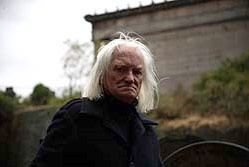
| HOME |
| NERVE |
| REVIEWS |
| ARCHIVE |
| EVENTS |
| LINKS |
| ABOUT US |
| CONTRIBUTORS |
| BACK ISSUES |
| CONTACT US |
24/10/2006
 Matthew
Buckingham - A Sense Of The Unknowing
Matthew
Buckingham - A Sense Of The Unknowing
Matthew Buckingham is a New York-based artist who utilizes photography, film, video, audio, writing, and drawing to question the role social memory plays in contemporary life. Buckingham’s work has been shown at numerous institutions around the world, including The Museum of Modern Art, New York; the Moderna Museet, Stockholm; and the Corcoran Gallery of Art, Washington, DC, among several others. He has received grants from the New York State Council on the Arts and the Danish Film Institute in addition to a German Academic Exchange Service Artist Residency Grant and a Henry and Natalie Freund Teaching Fellowship at the Washington University School of Art.
He was recently invited to produce a piece for this years Liverpool Biennial and opted to adapt a short story by the great American author, Herman Melville, retelling the tale through the medium of video.
What first inspired you to become an artist?
I was always interested in art. If I look at the ‘nurture’
part of the ‘nature’ /‘nurture’ dichotomy many
of the influences are obvious. My father was an elementary (grades K to
6) art teacher, and my stepmother was a librarian. In some ways I think
I eventually became interested in something like a synthesis of these
two fields.
What kind of environment do you prefer to
work in? Do you always need a vibrant atmosphere or do you ever opt for
solitude?
I suppose both are important at different times, but always in connection.
All of the social levels of art practice and production are important
and interesting to me. I think I use my alone-time to reflect on these
questions and work with a model of writing, which is again aimed at public
discourse.
A lot of your previous work has explored history
and literature. Are they your main sources of inspiration?
I’m very interested in the slippery and seemingly necessary conditions
of history, history writing and particularly historiography for understanding
the present. The practice of historical writing always weaves in and out
of literary concerns and conventions. As an intersection of the two, what
I try to focus on is the how the present moment is defined by our processes
of memory, and how ‘social-memory’ and ‘historical-memory’
are often at odds, especially where questions of ‘site’ or
‘place’ are concerned.
Regarding your recent piece in the Liverpool
Biennial, what was it about Melville’s short story that inspired
you to retell it through the medium of video?
I was interested to invest the sense of ‘unknowing’ and ambiguity
that exists in the original into the camera/editing of the project. In
other words, to see what new ambiguities or questions of knowledge might
arise if I used the tale as a blue-print for images and actions without
using the original text.
Why did you select Liverpool to film this
piece in?
Liverpool was Melville’s first port of call as a young sailor and
‘Daniel Orme’, on which my project is based, was perhaps the
last thing Melville wrote. I thought that in terms of life-experience
and particularly the memory of a working life (Orme’s and Melville’s)
these would be interesting parameters in the context of a port city that
has changed so radically during the last fifty years.
Finally, if you had not gone into visual arts
where would you be now?
Having thought about it almost exclusively since about the age of five
it’s a hard question to answer, but I often see a parallel between
my interests and journalism.
To see a review of the Biennial exhibition which features Matthew's work, click here.